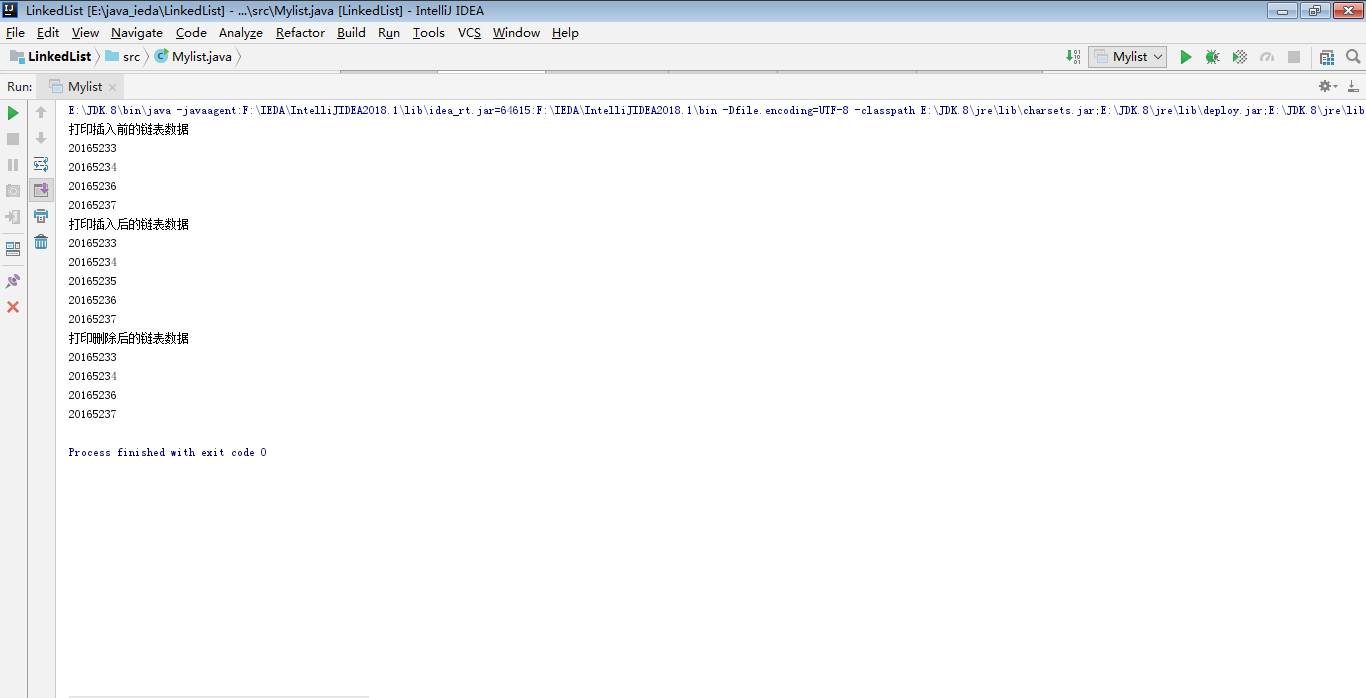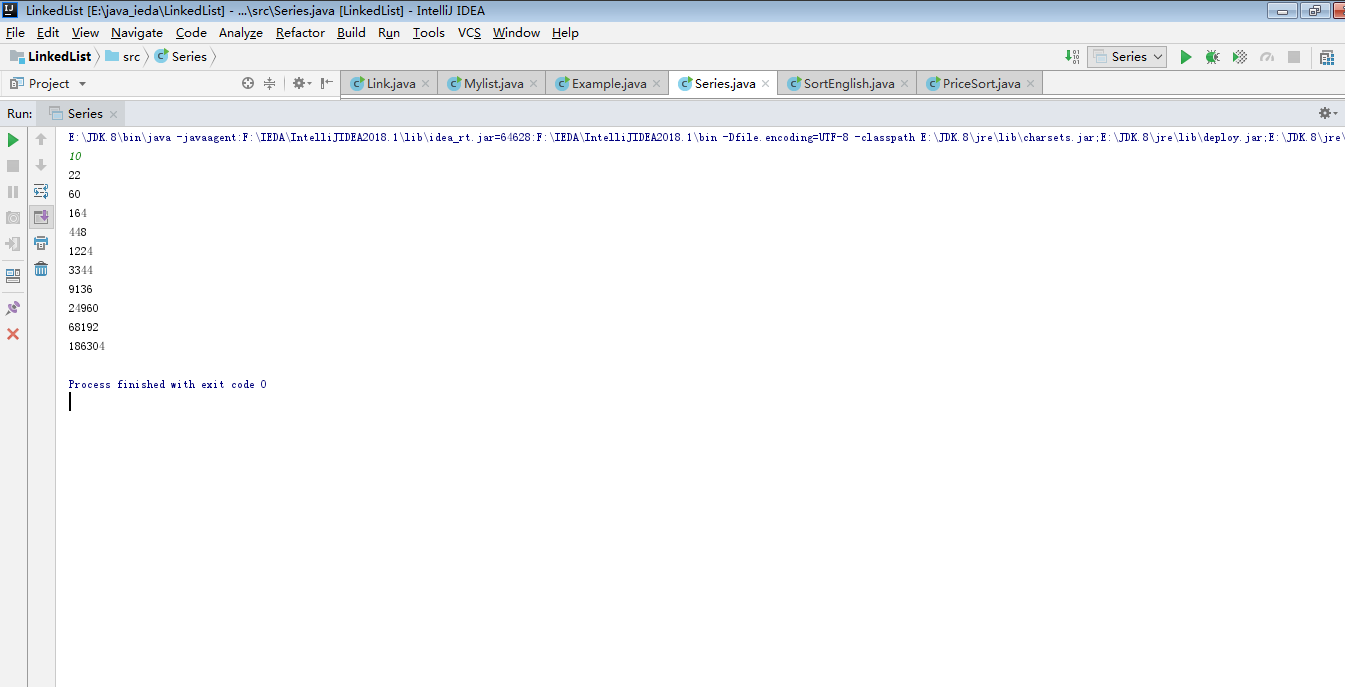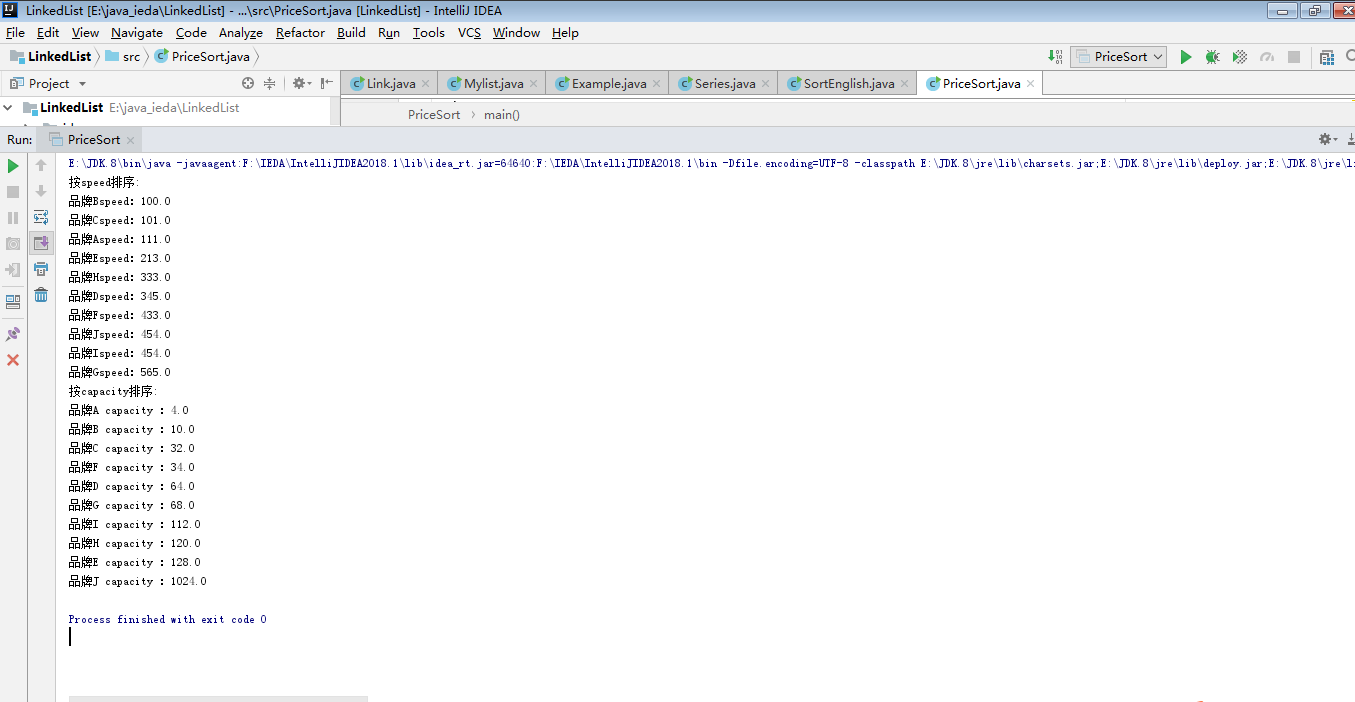20165235 祁瑛 第十周课下补做
相关知识点的总结
LinkedList<String> mylist=new LinkedList<String>()来创建一个链表。
mylist.add();来添加结点。
get(int index)来获取链表中第index个位置的结点的对象。
public static sort(List<E>)将链表中的元素升序排列
public static binarySearch(List<T>,T key,CompareTo<T>c):使用折半查找list中的数据Key;
实现Comparable接口要重写compareTo方法。Collections类中的sort方法是面向Comparable接口设计的。
课上内容的补做,结果截图
数据结构-排序
import java.util.*;
public class Example {
public static void main(String[] args) {
List<Student> list = new LinkedList<>();
list.add(new Student(20165233,"张雨昕",99,91,89));
list.add(new Student(20165234,"刘京甫",76,66,95));
list.add(new Student(20165235,"祁 瑛",77,81,68));
list.add(new Student(20165236,"郭金涛",89,45,66));
list.add(new Student(20165237,"方若鸿",82,80,86));
SortTotal_score sortBytotal_score = new SortTotal_score();
Collections.sort(list, sortBytotal_score);
SortID sortByID = new SortID();
Collections.sort(list, sortByID);
System.out.println("学号排序:");
for (Student student : list) {
System.out.println(student);
}
Collections.sort(list, sortBytotal_score);
System.out.println("成绩排序:");
for (Student student : list) {
System.out.println(student);
}
}
}
class Student {
private int id;//表示学号
private String name;//表示姓名
private int age;//表示年龄
private String sex;
private double computer_score;//表示计算机课程的成绩
private double english_score;//表示英语课的成绩
private double maths_score;//表示数学课的成绩
private double total_score;// 表示总成绩
private double ave_score; //表示平均成绩
@Override
public String toString() {
return " "+name+" "+id+" "+total_score;
}
public Student(int id, String name,double computer_score,
double english_score,double maths_score) {
this.id = id;
this.name = name;
this.computer_score = computer_score;
this.english_score = english_score;
this.maths_score = maths_score;
}
public int getId() {
return id;
}//获得当前对象的学号,
public double getComputer_score() {
return computer_score;
}//获得当前对象的计算机课程成绩,
public double getMaths_score() {
return maths_score;
}//获得当前对象的数学课程成绩,
public double getEnglish_score() {
return english_score;
}//获得当前对象的英语课程成绩,
public void setId(int id) {
this.id = id;
}// 设置当前对象的id值,
public void setComputer_score(double computer_score) {
this.computer_score = computer_score;
}//设置当前对象的Computer_score值,
public void setEnglish_score(double english_score) {
this.english_score = english_score;
}//设置当前对象的English_score值,
public void setMaths_score(double maths_score) {
this.maths_score = maths_score;
}//设置当前对象的Maths_score值,
public double getTotalScore() {
total_score=computer_score + maths_score + english_score;
return total_score;
}// 计算Computer_score, Maths_score 和English_score 三门课的总成绩。
public double getAveScore() {
return getTotalScore() / 3;
}// 计算Computer_score, Maths_score 和English_score 三门课的平均成绩。
}
class SortID implements Comparator<Student> {
@Override
public int compare(Student a, Student b) {
return a.getId() - b.getId();
}
}
class SortTotal_score implements Comparator<Student> {
@Override
public int compare(Student a, Student b) {
return (int)( a.getTotalScore() - b.getTotalScore());
}
}

数据结构单链表
import java.util.*;
public class Mylist {
public static void main(String [] args) {
//选用合适的构造方法,用你学号前后各两名同学的学号创建四个结点
Node<String> node1 =new Node<String>("20165233",null);
Node<String> node2 =new Node<String>("20165234",null);
Node<String> node3 =new Node<String>("20165236",null);
Node<String> node4 =new Node<String>("20165237",null);
//把上面四个节点连成一个没有头结点的单链表
node1.next=node2;
node2.next=node3;
node3.next=node4;
node4.next=node1;
//遍历单链表,打印每个结点的
Node<String> node =node1 ;
System.out.println("打印插入前的链表数据");
for (int i=0;i<4;i++) {
System.out.println(node.data.toString());
node = node.next;
}
//把你自己插入到合适的位置(学号升序)
//遍历单链表,打印每个结点的
System.out.println("打印插入后的链表数据");
node=node1;
Node<String> s=new Node<String>("20165235",null);
for(int i=0;i<5;i++){
System.out.println(node.data.toString());
node = node.next;
if(node==node2){
node2.next=s;
s.next=node3;
}
}
//从链表中删除自己
node=node1;
for(int i=0;i<4;i++){
node = node.next;
if(node==s){
s=null;
node2.next=node3;
node3.next=node4;
}
}
node =node1 ;
System.out.println("打印删除后的链表数据");
for (int i=0;i<4;i++) {
System.out.println(node.data.toString());
node = node.next;
}
}
}
class Node<String> //单链表结点类,T指定结点的元素类型
{
public String data; //数据域,存储数据元素
public Node<String> next; //地址域,引用后继结点
public Node(String data, Node<String> next) //构造结点,data指定数据元素,next指定后继结点
{
this.data = data; //T对象引用赋值
this.next = next; //Node<T>对象引用赋值
}
public Node()
{
this(null, null);
}
@Override
public java.lang.String toString() //返回结点数据域的描述字符串
{
return this.data.toString();
}
}

教材第十五章的代码分析
import java.util.*;
public class Example15_2 {
public static void main(String args[]){
List<String> list=new LinkedList<String>();//建立一个String类型的链表
for(int i=0;i<=60096;i++){
list.add("speed"+i);//对链表插入节点
}
Iterator<String> iter=list.iterator();//用iterator()方法获得一个Iterator对象
long starttime=System.currentTimeMillis();
while(iter.hasNext()){//当链表中还有数据时返回true
String te=iter.next();//te指向下一个节点
}
long endTime=System.currentTimeMillis();
long result=endTime-starttime;
System.out.println("使用迭代器遍历集合所用时间:"+result+"毫秒");
starttime=System.currentTimeMillis();
for(int i=0;i<list.size();i++){
String te=list.get(i);
}
endTime=System.currentTimeMillis();
result=endTime-starttime;
System.out.println("使用get方法遍历集合所用时间:"+result+"毫秒");
}
}
import java.util.*;
public class Example15_3 {
public static void main(String args[]){
LinkedList mylist=new LinkedList();//建立链表
mylist.add("你"); //链表中的第一个节点
mylist.add("好"); //链表中的第二个节点
int number=mylist.size(); //获取链表的长度
for(int i=0;i<number;i++){
String temp=(String)mylist.get(i); //必须强制转换取出的数据
System.out.println("第"+i+"节点中的数据:"+temp);
}
Iterator iter=mylist.iterator();
while(iter.hasNext()) {
String te=(String)iter.next(); //必须强制转换取出的数据
System.out.println(te);
}
}
}
import java.util.*;
class Student implements Comparable { //实现Comparab接口
int height=0;
String name;
Student(String n,int h) {
name=n;
height = h;
}
public int compareTo(Object b) { // 重写接口中的compareTo方法,两个Student对象相等当且仅当二者的height值相等
Student st=(Student)b;
return (this.height-st.height);
}
}
public class Example15_4 {
public static void main(String args[ ]) {
List<Student> list = new LinkedList<Student>();
list.add(new Student("张三",188));//第一个节点
list.add(new Student("李四",178));//第二个节点
list.add(new Student("周五",198)); //的三个接点
Iterator<Student> iter=list.iterator();
System.out.println("排序前,链表中的数据");
while(iter.hasNext()){
Student stu=iter.next();
System.out.println(stu.name+ "身高:"+stu.height);
}//遍历链表
Collections.sort(list);//使用Collections类的静态方法sort来升序排序
System.out.println("排序后,链表中的数据");
iter=list.iterator();
while(iter.hasNext()){
Student stu=iter.next();
System.out.println(stu.name+ "身高:"+stu.height);
}
Student zhaoLin = new Student("zhao xiao lin",178);
int index = Collections.binarySearch(list,zhaoLin,null);//使用Collections中的静态方法binarySearch()方法进行折半查找
if(index>=0) {
System.out.println(zhaoLin.name+"和链表中"+list.get(index).name+"身高相同");
}
}
}
import java.util.*;
public class Example15_5 {
public static void main(String args[ ]) {
List<Integer> list = new LinkedList<Integer>//建立一个int类型的链表
for(int i=10;i<=50;i=i+10)//添加5个节点
list.add(new Integer(i));
System.out.println("洗牌前,链表中的数据");
Iterator<Integer> iter=list.iterator();
while(iter.hasNext()){
Integer n=iter.next();
System.out.printf("%d ",n.intValue());
}
Collections.shuffle(list);//将list中的数据重新排列
System.out.printf("
洗牌后,链表中的数据
");
iter=list.iterator();
while(iter.hasNext()){
Integer n=iter.next();
System.out.printf("%d ",n.intValue());
}
System.out.printf("
再向右旋转1次后,链表中的数据
");
Collections.rotate(list,1);//翻转list中的数据
iter=list.iterator();
while(iter.hasNext()){
Integer n=iter.next();
System.out.printf("%d ",n.intValue());
}
}
}
`import java.util.*;
public class Example15_6 {
public static void main(String args[]) {
Stack<Integer> stack=new Stack<Integer>();//建立一个int类型的堆栈
stack.push(new Integer(1)); //将1压栈
stack.push(new Integer(1));//将1压栈,现在栈中两个数
int k=1;
while(k<=10) {//求10个斐波那契数
for(int i=1;i<=2;i++) {
Integer F1=stack.pop();//弹栈第一个数
int f1=F1.intValue();
Integer F2=stack.pop();//弹栈第二个数
int f2=F2.intValue();
Integer temp=new Integer(f1+f2);
System.out.println(""+temp.toString());
stack.push(temp);//两数之和压栈
stack.push(F2);//第二个数压栈
k++;
}
}
}
}
import java.util.*;
class Student implements Comparable {
int english=0;
String name;
Student(int english,String name) {
this.name=name;
this.english=english;
}
public int compareTo(Object b) {//重写compareTo方法
Student st=(Student)b;//Object类型强制转化为Student类
return (this.english-st.english);
}
}
public class Example15_8 {
public static void main(String args[]) {
TreeSet<Student> mytree=new TreeSet<Student>();
Student st1,st2,st3,st4;
st1=new Student(90,"赵一");
st2=new Student(66,"钱二");
st3=new Student(86,"孙三");
st4=new Student(76,"李四");
mytree.add(st1);//添加数集结点
mytree.add(st2);
mytree.add(st3);
mytree.add(st4);
Iterator<Student> te=mytree.iterator();
while(te.hasNext()) {//遍历树集结点
Student stu=te.next();
System.out.println(""+stu.name+" "+stu.english);
}
}
}
import java.util.*;
class StudentKey implements Comparable {
double d=0;
StudentKey (double d) {
this.d=d;
}
public int compareTo(Object b) {//重写compareTo方法
StudentKey st=(StudentKey)b;//强制转化为StudentKey类型
if((this.d-st.d)==0)
return -1;
else
return (int)((this.d-st.d)*1000);
}
}
class Student {
String name=null;
double math,english;
Student(String s,double m,double e) {
name=s;
math=m;
english=e;
}
}
public class Example15_9 {
public static void main(String args[ ]) {
TreeMap<StudentKey,Student> treemap= new TreeMap<StudentKey,Student>();
String str[]={"赵一","钱二","孙三","李四"};
double math[]={89,45,78,76};
double english[]={67,66,90,56};
Student student[]=new Student[4];
for(int k=0;k<student.length;k++) {
student[k]=new Student(str[k],math[k],english[k]);
}
StudentKey key[]=new StudentKey[4] ;
for(int k=0;k<key.length;k++) {
key[k]=new StudentKey(student[k].math); //关键字按数学成绩排列大小
}
for(int k=0;k<student.length;k++) {
treemap.put(key[k],student[k]);
}
int number=treemap.size();//获取treemap的元素个数
System.out.println("树映射中有"+number+"个对象,按数学成绩排序:");
Collection<Student> collection=treemap.values();//获取数据
Iterator<Student> iter=collection.iterator();
while(iter.hasNext()) {
Student stu=iter.next();
System.out.println("姓名 "+stu.name+" 数学 "+stu.math);
}
treemap.clear();//清空树映射
for(int k=0;k<key.length;k++) {
key[k]=new StudentKey(student[k].english);//关键字按英语成绩排列大小
}
for(int k=0;k<student.length;k++) {
treemap.put(key[k],student[k]);
}
number=treemap.size();
System.out.println("树映射中有"+number+"个对象:按英语成绩排序:");
collection=treemap.values();
iter=collection.iterator();
while(iter.hasNext()) {
Student stu=(Student)iter.next();
System.out.println("姓名 "+stu.name+" 英语 "+stu.english);
}
}
}
补做教材第十五章的编程题目
编程题一
import java.util.*;
public class Series {
public static void main(String args[]){
Stack<Integer> stack =new Stack<Integer>();
Scanner scanner=new Scanner(System.in);
int n=scanner.nextInt();
int a1=3;
int a2=8;
stack.push(a1);//第一个数压栈
stack.push(a2);//第二个数压栈
int temp=0;//计算结果设一个中间变量temp
for(int i=0;i<n;i++){
a2=stack.pop();//弹出第二个数
a1=stack.pop();//弹出第一个数
temp=2*a2+2*a1;//计算结果
stack.push(a2);//第二个数压栈
stack.push(temp);//计算结果压栈
System.out.println(temp);
}
}
}

编程题二
import java.util.*;
public class SortEnglish {
public static void main(String args[]) {
TreeSet<Score> mytree = new TreeSet<>();
List<Score> mylist = new LinkedList<Score>();
mylist.add(new Score("赵一", 89));
mylist.add(new Score("钱二", 99));
mylist.add(new Score("孙三", 100));
mylist.add(new Score("李四", 92));
mylist.add(new Score("周五", 88));
//添加节点
Iterator<Score> score = mylist.iterator();
System.out.println("排序之前的:");
while (score.hasNext()) {
Score sco = score.next();
mytree.add(sco);
System.out.println(sco.name + " " + sco.english);
}
//将链表中的成绩放入树集中
System.out.println("排序之后的:");
Iterator<Score> te = mytree.iterator();
while (te.hasNext()) {
Score stu = te.next();
System.out.println("" + stu.name + " " + stu.english);
}
}
}
class Score implements Comparable {
int english = 0;
String name = "";
Score(String name, int english) {
this.name = name;
this.english = english;
}
@Override
public int compareTo(Object a) {
Score b = (Score) a;
return this.english - b.english;
}
}

编程题三
import java.util.*;
class Sort implements Comparable {
double d=0;
Sort (double d) {
this.d=d;
}
@Override
public int compareTo(Object b) {
Sort st=(Sort) b;
if((this.d-st.d)==0) {
return -1;
}
else {
return (int) ((this.d - st.d) * 1000);
}
}
}
class U {
String name="";
double speed,capacity;
U(String name,double speed,double capacity) {
this.name=name;
this.capacity=capacity;
this.speed=speed;
}
}
public class PriceSort {
public static void main(String args[ ]) {
TreeMap<Sort,U> treemap= new TreeMap<Sort,U>();
String name[]={"A","B","C","D","E","F","G","H","I","J"};
double speed[]={111,100,101,345,213,433,565,333,454,454};
double capacity[]={4,10,32,64,128,34,68,120,112,1024};
U u[]=new U[10];
for(int k=0;k<u.length;k++) {
u[k]=new U(name[k],speed[k],capacity[k]);
}
Sort key[]=new Sort[10] ;
for(int k=0;k<key.length;k++) {
key[k]=new Sort(u[k].speed);
}
for(int k=0;k<u.length;k++) {
treemap.put(key[k],u[k]);
}
System.out.println("按speed排序:");
Collection<U> collection=treemap.values();
Iterator<U> iter=collection.iterator();
while(iter.hasNext()) {
U stu=iter.next();
System.out.println("品牌"+stu.name+"speed:"+stu.speed);
}
treemap.clear();
for(int k=0;k<key.length;k++) {
key[k]=new Sort(u[k].capacity);
}
for(int k=0;k<u.length;k++) {
treemap.put(key[k],u[k]);
}
System.out.println("按capacity排序:");
collection=treemap.values();
iter=collection.iterator();
while(iter.hasNext()) {
U stu=(U)iter.next();
System.out.println("品牌"+stu.name+" capacity :"+stu.capacity);
}
}
}

心得体会
本次测试我没有能够做出排序和单链表的题目,一是考试时间过短,二是对数据结构这块内容学习的不够深。而通过本次课下补做我对数据结构的了解有进了一步。